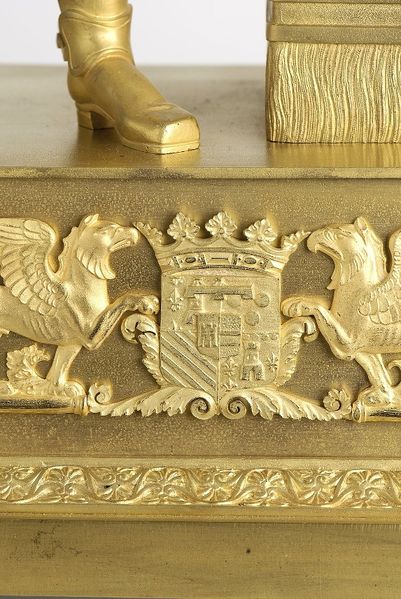Datei:Lesieur à Paris, circa 1800 (2).jpg

Originaldatei (573 × 856 Pixel, Dateigröße: 249 KB, MIME-Typ: image/jpeg)
Lesieur à Paris, Höhe 520 mm, circa 1800
Hochfeine, seltene Figuren Kaminuhr mit Selbstschlag.
Geh.: Bronze, feuervergoldet, die vollplastisch gearbeitete Figur des vermutlich schwedischen Königs Gustav II. Adolf wird flankiert von einem hochrechteckigen Sockel, in dem sich das Uhrwerk befindet. Auf dem Sockel der federgeschmückte Hut des Königs auf drei Landkarten liegend, die untere mit deutschen Städtenamen, die obere mit Gebietseinzeichnungen und den Bezeichnungen "Mer Baltique" und "Prussia". Rechteckige Plinthe, die Schauflächen dekoriert mit Akanthusranken, die Front mit zwei geflügelten Greifen, die ein gekröntes Wappenschild flankieren. Über die Ecken gestellte, volutenverzierte Klauenfüße. Ziffbl.: Email, radiale röm. Zahlen, signiert, gebläute Breguet-Zeiger. Werk: rundes Messing-Vollplatinenwerk, signiert, vergoldet, 1 Hammer / 1 Glocke, 2 Federhäuser, Schlüsselaufzug, 8-Tage-Werk, Hakenhemmung, Schlossscheibe, Fadenaufhängung, Kurzpendel.
A very fine and rare figure mantel clock with sonnerie.
Case: bronze, firegilt; the sculpture of probably King Gustav II Adolf of Sweden stands next to an upright rectangular plinth which holds the clock. The Kings’s feathered hat rests on three maps on the plinth; the bottom one lists names of German cities, the top one shows regions with the names "Mer Baltique" and "Prussia". On a rectangular plinth decorated with scrolls of acanthus and two griffins flanking a shield on the front. Claw-feet with volute decoration. Dial: enamel, radial Roman numerals, signed, blued Breguet hands. Movm.: round brass full plate movement, signed, gilt, 1 hammer / 1 bell, 2 barrels, keywind, 8 day-movement, anchor escapement, count wheel, silk string suspension, short pendulum.
Gustav II Adolf (1594 – 1632)
He has been widely known in English by his Latinized name Gustavus Adolphus Magnus and variously in historical writings also as Gustavus, or Gustavus the Great, or Gustav Adolph the Great (Swedish: Gustav Adolf den store, a formal distinction passed by the Swedish Parliament in 1634). He was King of Sweden (1611–1632) and founder of the Swedish Empire (or Stormaktstiden – "the era of great power") at the beginning of the Golden Age of Sweden. He led his nation to military supremacy during the Thirty Years War, helping to determine the political as well as the religious balance of power in Europe. He is thereby regarded as one of the greatest military commanders of all time. His most notable military victory was the battle of Breitenfeld. With a superb military machine with good weapons, excellent training, and effective field artillery, backed by an efficient government which could provide necessary funds, Gustavus Adolphus was poised to make himself a major European leader, but he was killed at the battle of Lützen in 1632. He was assisted by Axel Oxenstierna (1583–1654), leader of the nobles who also acted as regent after his death.

|
Alle Bildrechte liegen bei dem Auktionshaus Auktionen Dr. H. Crott. Diese Abbildung ist urheberrechtlich geschützt und steht nicht unter einer freien Lizenz. Für anderweitige Nutzungen außerhalb von Watch-Wiki ist die schriftliche Zustimmung des Urheberrechtsinhabers nötig. |
Dateiversionen
Klicke auf einen Zeitpunkt, um diese Version zu laden.
| Version vom | Vorschaubild | Maße | Benutzer | Kommentar | |
|---|---|---|---|---|---|
| aktuell | 15:22, 28. Okt. 2012 |  | 573 × 856 (249 KB) | Andriessen (Diskussion | Beiträge) | Lesieur à Paris, Höhe 520 mm, circa 1800 Hochfeine, seltene Figuren Kaminuhr mit Selbstschlag.<br> Geh.: Bronze, feuervergoldet, die vollplastisch gearbeitete Figur des vermutlich schwedischen Königs Gustav II. Adolf wird flankiert von einem hochr… |
Du kannst diese Datei nicht überschreiben.
Dateiverwendung
Keine Seiten verwenden diese Datei.